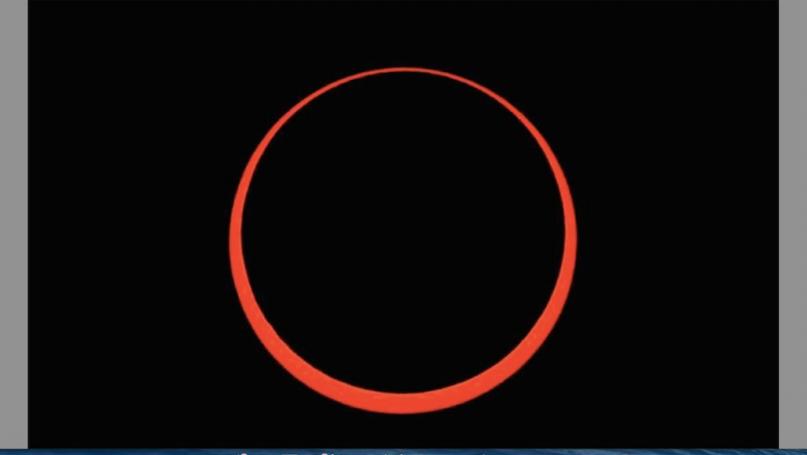
DAYTONA BEACH, Fla. -- Dr. Terry Oswalt, an astronomer and chair of the Department of Physical Sciences at Embry-Riddle Aeronautical University had some thoughts on the annular solar eclipse that happened in the Southern Hemisphere over the weekend.
“Sunday’s solar eclipse created a dramatic “ring of fire”–an annular eclipse–as the Moon slipped into position in front of the Sun,” Oswalt said. “Bright rays of sunlight flashed through valleys at the edge of the Moon and glimpses of the pink upper atmosphere, called the chromosphere, may have been seen in some locations.”
Here in Daytona Beach, folks could not see the “ring of fire,” as the eclipse crossed parts of southern Chile, Argentina and the South Atlantic (where mid-eclipse occurred at about 10:54 a.m. EST). It ended around sunset in South Africa.
“But be patient,” Oswalt said. “On Monday, Aug. 21, the Moon’s shadow will pass across the U.S. from northwest through the southeast and the eclipse of the Sun will be total.”
“Sunday’s solar eclipse created a dramatic “ring of fire”–an annular eclipse–as the Moon slipped into position in front of the Sun,” said Dr. Terry Oswalt, an astronomer and chair of the Department of Physical Sciences at Embry-Riddle Aeronautical University, shown here. “Bright rays of sunlight flashed through valleys at the edge of the Moon and glimpses of the pink upper atmosphere, called the chromosphere, may have been seen in some locations.”
Here in Daytona Beach, folks could not see the “ring of fire,” as the eclipse crossed parts of southern Chile, Argentina and the South Atlantic (where mid-eclipse occurred at about 10:54 a.m. EST). It ended around sunset in South Africa. “But be patient,” Oswalt said. “On Monday, Aug. 21, the Moon’s shadow will pass across the U.S. from northwest through the southeast and the eclipse of the Sun will be total.”
If you want to learn more about solar eclipses and would like a chance to look through Embry-Riddle’s powerful 1-meter (40-inch) telescope, join the Amateur Astronomy Club and Embry-Riddle Observatories for their Astronomy Lecture and Observatory Open House, and you can Watch Sunday’s annular eclipse at: https://phys.org/news/2017-02-stargazers-moon-eclipses-sun.html, 7 p.m. Friday, Friday, March 3, Embry-Riddle Astronomy Lecture & Observatory Open House.
“Detecting Colliding Black Holes” with Dr. Gabriela González, 7 p.m. – Willie Miller Instructional Center, Lemerand Auditorium:
The Fred Elston Memorial Lecture Series welcomes Dr. Gabriela González, an experimental physicist and professor of physics and astronomy at LSU and leader of the LIGO Scientific Collaboration. LIGO stands for Laser Interferometer Gravitational Wave Observatory, consisting of two detectors located in Louisiana and Washington.
The LSC is a group of more than 1,000 scientists worldwide (including a group at the Embry–Riddle Prescott (Ariz.) Campus. Their successful detection of a wave created by two colliding black holes, more than 1.3 billion light years away, has been hailed across the scientific community as a historical turning point as significant and game–changing as the moment Galileo first pointed his telescope to the sky.
Gravitational Waves are ripples in the fabric of space and time caused by violent events in the distant universe, including the collision of black holes and supernova explosions. It’s been said that Galileo gave humankind the eyes with which to see the universe. The scientists and engineers involved with LIGO have now given us the ears.
“We can now hear the universe talking to us,” said González. This Fred Elston Memorial Lecture on Gravitation is presented by the Physical Sciences Department and College of Arts & Sciences, Embry–Riddle Observatory’s Open House, 8 p.m. – College of Arts & Sciences Building.
The observatory is home to the largest university–based research telescope in Florida, the 1–meter (40–inch) Ritchey–Chrétien reflecting telescope, plus six rooftop–observing stations for smaller telescopes. Everyone is welcome to come view the panorama of the night sky. Hosted by the Embry–Riddle Amateur Astronomy Club and the Embry–Riddle Observatory, the Astronomy Lecture and Open House events are free and open to the public.
For more information, please call call 386-226–6010.
